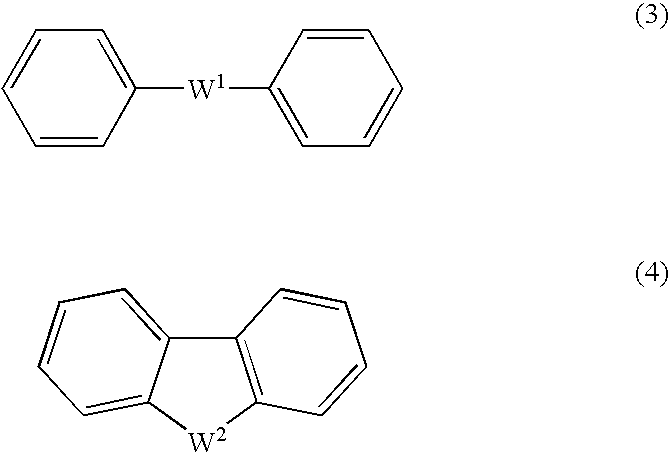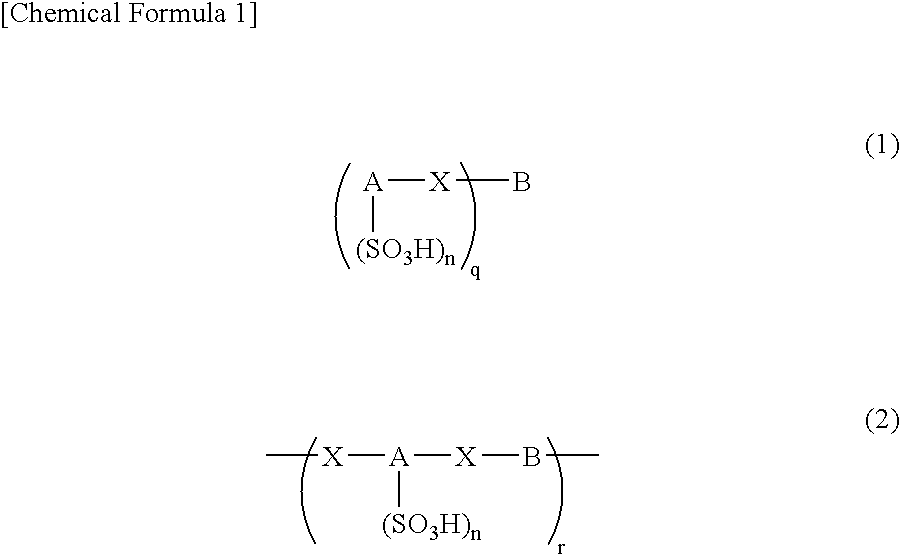Arylsulfonic Acid Compound And Use Thereof As Electron -Acceptor Material
a technology of arylsulfonic acid and electron acceptor, which is applied in the direction of non-metal conductors, conductors, organic chemistry, etc., can solve the problems of limited use of electron acceptors, limited coating methods capable of forming uniform films, and substantial deterioration of characteristics, so as to improve the initial characteristics, improve the effect of el device characteristics and low solubility
- Summary
- Abstract
- Description
- Claims
- Application Information
AI Technical Summary
Benefits of technology
Problems solved by technology
Method used
Image
Examples
example 1
[0138] According to the reaction scheme (14) below, a naphthalenedisulfonic acid compound oligomer 1 (hereinafter abbreviated as “NSO-1”) was synthesized.
[0139] Described specifically, perfluorobiphenyl (449 mg), 60% sodium hydride (161 mg) and anhydrous N,N-dimethylimidazolidinone (50 mL) were successively added under a nitrogen atmosphere to dipotassium 2-naphthol-6,8-disulfonate (product of Tokyo Chemical Industry Co., Ltd., 1.020 g) which had been dried thoroughly. After the reaction system was purged with nitrogen, the resulting mixture was stirred at 80° C. for 43 hours.
[0140] The reaction mixture was allowed to cool down to room temperature, followed by the addition of water to terminate the reaction. The reaction mixture was then concentrated to dryness under reduced pressure. Methanol (5 mL) was added to the residue, and the thus-obtained suspension was added to diethyl ether (100 mL) under stirring. Subsequent to stirring at room temperature for one hour, the precipitat...
example 2
[0144] According to the reaction scheme (15) below, a naphthalenedisulfonic acid compound oligomer 2 (hereinafter abbreviated as “NSO-2”) was synthesized.
[0145] Described specifically, perfluorobiphenyl (450 mg), 60% sodium hydride (166 mg) and anhydrous N,N-dimethylimidazolidinone (50 mL) were successively added under a nitrogen atmosphere to sodium 1-naphthol-3,6-disulfonate (product of Tokyo Chemical Industry Co., Ltd., 934 mg) which had been dried thoroughly. After the reaction system was purged with nitrogen, the resulting mixture was stirred at 80° C. for 43 hours.
[0146] The reaction mixture was allowed to cool down to room temperature, followed by the addition of water to terminate the reaction. The reaction mixture was then concentrated to dryness under reduced pressure. Methanol (5 mL) was added to the residue, and the thus-obtained suspension was added to diethyl ether (100 mL) under stirring. Subsequent to stirring at room temperature for 1 hour, the precipitated solid...
synthesis example 1
Synthesis of Phenyltetraaniline
[0150]
[0151] Based on the process described in Bulletin of Chemical Society of Japan, 67, pp. 1749-1752 (1994), phenyltetraaniline (PTA) was obtained as will be described hereinafter.
[0152] Described specifically, p-phenylenediamine (12.977 g) was dissolved in toluene (2 L). To the resulting solution, tetra-n-butoxytitanium (245.05 g) was added as a dehydration condensing agent, followed by dissolution at 70° C. for 30 minutes. p-Hydroxydiphenylamine (53.346 g) was then added, and under a nitrogen atmosphere, was reacted at a reaction temperature of 100° C. for 24 hours. After completion of the reaction, the reaction mixture was filtered. The filter cake was washed successively with toluene and ether, and was then dried to obtain crystals of a silver color. To the thus-obtained crystals, dioxane (25 parts by weight) and hydrazine monohydrate (0.2 equivalent) were added. After the reaction system was purged with nitrogen, the mixture was refluxed unde...
PUM
| Property | Measurement | Unit |
|---|---|---|
| Mass | aaaaa | aaaaa |
| Electric charge | aaaaa | aaaaa |
| Electric potential / voltage | aaaaa | aaaaa |
Abstract
Description
Claims
Application Information
 Login to View More
Login to View More - R&D
- Intellectual Property
- Life Sciences
- Materials
- Tech Scout
- Unparalleled Data Quality
- Higher Quality Content
- 60% Fewer Hallucinations
Browse by: Latest US Patents, China's latest patents, Technical Efficacy Thesaurus, Application Domain, Technology Topic, Popular Technical Reports.
© 2025 PatSnap. All rights reserved.Legal|Privacy policy|Modern Slavery Act Transparency Statement|Sitemap|About US| Contact US: help@patsnap.com



